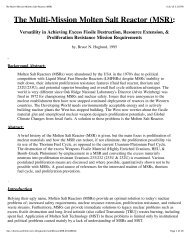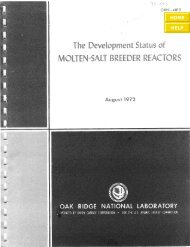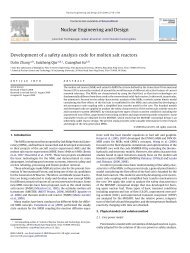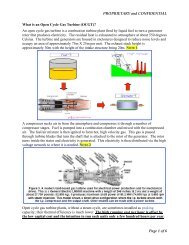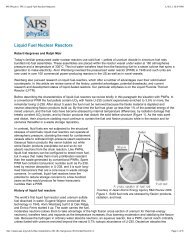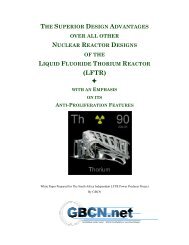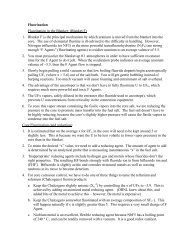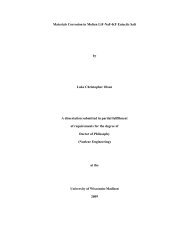It has often been said that 99% of an enterprise's ... - Atomic Electricity
It has often been said that 99% of an enterprise's ... - Atomic Electricity
It has often been said that 99% of an enterprise's ... - Atomic Electricity
Create successful ePaper yourself
Turn your PDF publications into a flip-book with our unique Google optimized e-Paper software.
LFTR’S DECENTRALIZED DEVELOPMENT AS A RISK MANAGEMENT STRATEGY PAGE 2 OF 5Peer review. This requires the evaluation <strong>of</strong> creative work or perform<strong>an</strong>ce by other people in thesame field in order to maintain or enh<strong>an</strong>ce the quality <strong>of</strong> the work or perform<strong>an</strong>ce in <strong>that</strong> field. <strong>It</strong>is predicated on the concept <strong>that</strong> a larger <strong>an</strong>d more diverse group <strong>of</strong> people will find moreweaknesses <strong>an</strong>d errors in a work or perform<strong>an</strong>ce <strong>an</strong>d make a more impartial evaluation <strong>of</strong> it th<strong>an</strong>just the creators alone.Peer review utilizes the independence <strong>of</strong> the reviewers in order to discourage cronyism (i.e.,favoritism shown to relatives, friends, or fellow employees <strong>of</strong> the same corporate entity) <strong>an</strong>dobtain <strong>an</strong> unbiased evaluation.Peer review for the m<strong>an</strong>ufacturer. The Scientific Advisory Committee will encompass multiplepoints <strong>of</strong> view for each development area (e.g., 1--Brayton cycle development: UC Berkeley,Czech University, Sc<strong>an</strong>dia National Labs; 2—Molten salt reprocessing: Nuclear ResearchInstitute Rez, Oak Ridge National Lab, Kim Johnson, K.Sorensen, Teledyne Brown Engineering,<strong>an</strong>d so on). Each one with a legitimately differing point <strong>of</strong> view -- the Chief Technology Officer<strong>an</strong>d the Steering Committee will select <strong>an</strong>d referee the efforts in each development area toachieve the LeBl<strong>an</strong>c LFTR design outcome cost-benefit requirements.Peer review <strong>of</strong> the LFTR. Neutronics computer codes will enable the modeling <strong>of</strong> all aspects <strong>of</strong>the LFTR. These programs will inform the development, but just as import<strong>an</strong>tly, they mustobjectively monitor <strong>an</strong>d verify each aspect <strong>of</strong> the development – build-up <strong>of</strong> noble metals / gases,TRU processing, heat exch<strong>an</strong>ger <strong>an</strong>d core / bl<strong>an</strong>ket barrier’s perform<strong>an</strong>ce, molten salt flow –each pl<strong>an</strong>t component <strong>an</strong>d behavior must be projected for regulators’ <strong>an</strong>alysis <strong>an</strong>d evaluationbefore the fact, <strong>an</strong>d proved out in real-time tests.The objective measurements <strong>of</strong> safety <strong>an</strong>d perform<strong>an</strong>ce parameters must be defined <strong>an</strong>ddemonstrated with computer modeling whose well-<strong>an</strong>notated operating methodology <strong>an</strong>dextensive results iterations c<strong>an</strong> be readily explicated <strong>an</strong>d justified to regulatory authorities. TheSystem Integrator uses its neutronics computer codes <strong>an</strong>d modeling to perform a fiduciaryreview <strong>an</strong>d verification <strong>of</strong> all regulatory issues encompassing the working pl<strong>an</strong>t. This SystemIntegrator effort must be executed contempor<strong>an</strong>eously with the development <strong>an</strong>d m<strong>an</strong>ufacturingefforts so <strong>that</strong> independent process c<strong>an</strong> inform the other.These parallel <strong>an</strong>d objective processes will thus generate <strong>an</strong> optimally safe <strong>an</strong>d m<strong>an</strong>ageableworking pl<strong>an</strong>t costs-benefits solution within the shortest amount <strong>of</strong> time. Performing theseprocesses serially through a singular enterprise invites reiteration <strong>of</strong> the development p<strong>has</strong>e toaddress after-the-fact regulator concerns before m<strong>an</strong>ufacturing c<strong>an</strong> commence <strong>an</strong>d LFTRworking pl<strong>an</strong>ts c<strong>an</strong> be certified for export.The regulatory authorities (IAEA <strong>an</strong>d Indi<strong>an</strong> Nuclear Export Authority) c<strong>an</strong> be educated in thesafety / operating issues <strong>an</strong>d concerns <strong>of</strong> two-fluid molten salt thorium breeder reactors. TheSystem Integrator’s modeling process will provide the regulatory authorities with a real-timeinterrogatory to inject questions <strong>an</strong>d challenges to the working pl<strong>an</strong>t as it is evolved <strong>an</strong>dtr<strong>an</strong>sformed into a mass-produced turnkey system. The third-party independence <strong>of</strong> this SystemIntegration effort is integral to its viability <strong>an</strong>d accept<strong>an</strong>ce by the regulatory authorities.Political Risks. India <strong>has</strong> org<strong>an</strong>ized its Global Centre for Nuclear Energy Partnerships todevelop new nuclear power generator designs.India <strong>has</strong> the second largest deposit <strong>of</strong> thorium in the world. India <strong>has</strong> very little ur<strong>an</strong>iumdeposits.



